Unit 5 Into the unknown

Section Ⅰ Starting out & Understanding ideas
单词拼写 根据首字母或汉语提示,用本部分所学单词的正确形式填空。
1.Landing on Mars may inspire more people to learn about science and a .
2.My brother b himself in his studies when in high school and as a result he entered his ideal university.
3.A c is a human society with its own social organisation and culture.
4.Those suggestions shouldn’t be d without thinking about them.
5.The two (运河) have proved useful to the county in many ways.
6.One dead man was found in the (废墟) almost two hours after the explosion.
7. (离弃) a child under two years old is a crime.
8.The remarkable (扩大) of public high schools from 1900 to 1920 was very important.
选择填空 用方框中所给短语的适当形式填空。
all the more at one’s peak correspond to fall into ruin on top of
1.A large number of churches after the earthquake.
2.The wing of a bird the arm of a man.
3.Jenny likes the book for its beautiful illustrations.
4.As we know, the Tang Dynasty was in the early 8th century.
5. it being dark, it rained, which made the going even more difficult.
课文语法填空
Intrigued by Maya civilisation from a very young age, 15-year-old Canadian William Gadoury thought he had made an incredible 1 (discover) from his study of ancient star charts. Through comparison, he found that the locations of the 117 known Maya cities correspond to the positions of the stars. Based on this, he believed he had spotted an unknown Maya city 2 (bury) deep in the jungle. Although his theory has been dismissed by scholars, it shows 3 powerful the secrets of Ancient Maya civilisation are among people.
It isn’t difficult to see why. Extending south from parts of what we now know as Mexico into Central America, Maya civilisation 4 (surround) by mystery since its rediscovery in the 19th century. The Maya built 5 (impress) palaces and temples, 6 (include) their representative step pyramids. What is most extraordinary about these complex structures is how they were built
7 the use of wheels, metal tools or even animal power. The Maya’s understanding of mathematics and astronomy was also quite amazing. They applied this understanding to the Maya calendar, which was accurate to within 30 seconds per year. On top of all this was 8 achievement unique in the Americas at that time: a true writing system. It contained more than 800 characters, with some signs representing animals, people and objects and others representing 9 (syllable). It was a writing system so complicated that, so far, no one has been able 10 (interpret) it completely.
1. 2. 3. 4. 5.
6. 7. 8. 9. 10.
阅读理解
A blue hole is a special kind of underwater cave found inland or in the sea, which forms when the earth above a cave falls in and water fills the space.
An inland blue hole’s water is very still and has different layers. A layer of fresh rainwater floats on top of salt water; the fresh water keeps oxygen from the atmosphere from reaching the salt water; brightly colored bacteria (细菌) live where the two layers meet.
Diving into blue holes is extremely dangerous. Near the top of the blue hole, there is a layer of toxic gas, which causes itching, dizziness, and—in large amounts—death. Divers must also be fast. They have to get in and out of a cave before their oxygen runs out. Additionally, divers have to follow a guideline as they swim through a blue hole because it is very dark inside. Without the guideline, they may get lost.
If blue holes are so dangerous, why do explorers and scientists risk their lives to explore them? The reason is that these underwater caves can provide valuable scientific information. They provide clues about geology, archaeology, and biology. For example, some blue hole creatures, such as the remipede, probably haven’t changed for millions of years.
The blue holes could even provide clues about astrobiology. For example, divers have found bacteria there that can live without oxygen. Astrobiologist Kevin Hand says the bacteria may be similar to forms of life that might exist on Jupiter’s fourth largest moon, Europa. “Our study of life’s extremes on Earth,” he says, “can help increase our understanding of habitable environments off Earth.”
1. What is the first paragraph mainly about?
A. The structure of a blue hole. B. The location of a blue hole.
C. The formation of a blue hole. D. The definition of a blue hole.
2. Where can bright-colored bacteria be found in a blue hole?
A. In the saltwater layer.
B. In the freshwater layer.
C. In between the freshwater and saltwater layers.
D. In both of the freshwater and saltwater layers.
3. What are blue holes like according to the text?
A. Oxygen-free and lifeless. B. Poisonous and dark.
C. Death zones and mazelike. D. Free of air and light.
4. Why do explorers and scientists like to explore blue holes?